PST ISU-152 vs. Italeri ISU-152 kits in
1/72
A Compare & Contrast Review
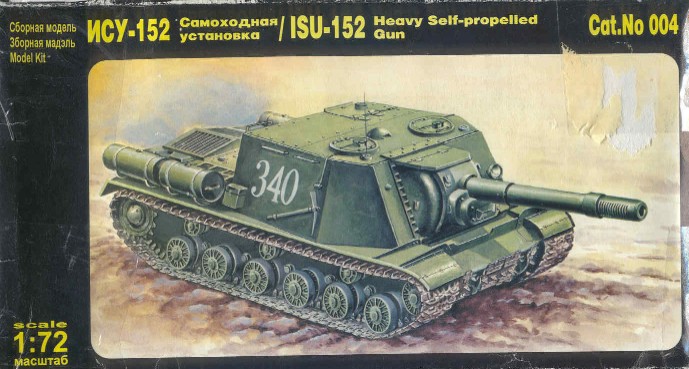
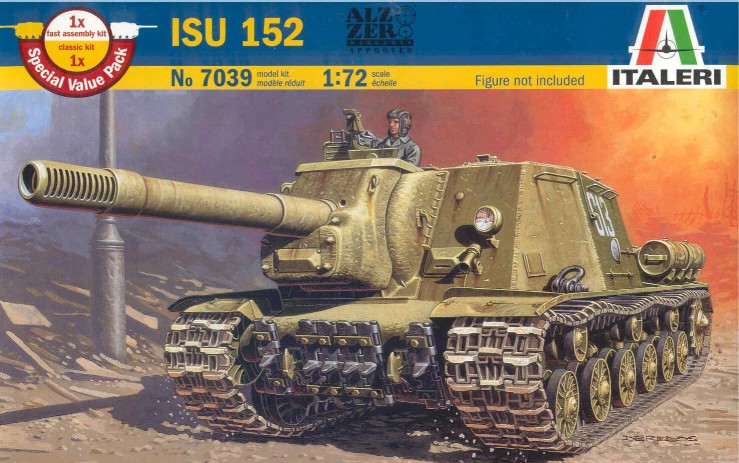
By Stephen Brezinski, November 2006
This imposing self propelled gun has long been one of my favorite
AFV’s from a visual and historical perspective. Reminiscent
of Grond from the movie Lord Of The Rings, the ISU-152 to me represents
a Soviet battering ram smashing its way west to Berlin. PST gave us
our first 1/72 scale injection-molded plastic kit of this vehicle
over five years ago, and now Italeri gives us their interpretation
of this vehicle.
Wee Bit of History for the Modeler
In order to deal with the assault of German fortifications, and new
powerfully armed and armored Panzers, Soviet engineers and industry
turned to mounting their 152-mm gun-howitzer and 122-mm cannon onto
their heavy tank chassis. Where the Soviet KV tank spawned the SU-152,
in 1944 the Ioseph Stalin tank was used for the ISU assault guns with
a high superstructure similar to that developed for the earlier SU-152.
You will notice that I use the term ISU and Ioseph Stalin tank is
used rather than JSU and Joseph Stalin. The way I recall, about 10
years ago modelers & historians from the former USSR let it be
more commonly known over the web and new reference books that with
no letter “J” in the Cyrillic alphabet, the correct translation
was with an “I”, hence “ISU”. Slowly this
has been becoming the norm. See the references for further details
on this.
The ISU-152 and ISU-122 went into service in early 1944 with the first
large-scale use in the summer of 1944 during operation Bagration.
Some typical scenes to model could be in the Soviet assaults on Budapest,
East Prussia and Berlin. The heavy armament made them formidable in
city fighting though I understand were hampered by a traverse of only
5 degrees left and right, slow reloading and low ammunition storage.
A limited number of ISU’s also served in the wartime and post
war Polish and Finnish armies, and Egyptian Army in the 1960’s.
The ISU-152 and ISU-122 were kept in production and service post-war,
and underwent upgrades that are the subject of some good scratchbuilding
projects. Like early German StuG’s and Ferdinands, early ISU’s
had no machine gun armament, so they relied on tank riders for protection
from infantry anti-tank weapons. In early 1945 it was common to see
them with roof mounted 13-mm machine guns [keep this in mind when
doing a diorama set in a particular time period].
The Kits
PST offers four different version of the ISU self propelled guns:
ISU-152 with a 152-mm ML20S gun-howitzer, the ISU-122 with a 122-mm
A-19S gun, ISU-122S with the D-5S gun and muzzle brake and different
mantlet, and an experimental SU-152-1 with a long 152-mm gun. They
come in four separate boxes but each kit contains all the parts for
each vehicle. Overall molding is decent, with some flash and thick
parts. PST gives us over 150-parts.
Italeri offers at this time only the ISU-152 though a 122-mm gun barrel
with muzzle break of the D-5S gun is also included within the kit.
The D-5S is the same gun used in the IS-2. If you look at the references
we will note that this gun used a different mantlet than the ML20S
howitzer and A-19S gun, so officially this spare gun barrel cannot
be used with this kit [unless you steal the spare mantlet from the
PST model]. The box comes with a regular kit with about 130 parts
including link & length tracks, open hatches, and individual wheels,
etc; and a wargaming kit of the ISU-152 comprising 9 parts.
Scale & Size Comparison
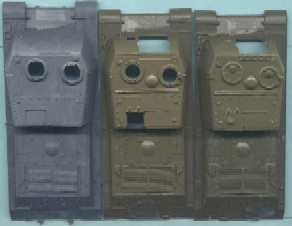
In the above scan it’s obvious that the gray PST upper at the
far right, is several millimeters longer and wider than Italeri’s,
though both claim to be 1/72. Most of PST’s additional length
is in the nose and in the engine deck; the superstructure length is
pretty much the same on both. A reference for length without the gun
barrel gives the length and width for the ISU at 6800-mm and 3070-mm
respectively. Based on these measurements, the PST kit measured at
approximately 1/73 length and width and so is closer to true 1/72
scale. The Italeri model measured out to be about 1/76 by length and
1/73 by width, being short in the nose and engine deck.
The Hulls
PST gives us two open hatches though a third rear hatch can be easily
cut open. The center hull is from Italeri’s display model kit
with open hatches while the hull at far right is their wargaming offering
with no open hatches. Both hulls are decently detailed though Italeri’s
molding is a bit more crisp and fine. Italeri’s ISU kits have
a better detailed hull bottom which will be a benefit in the event
you wish to model the tank on its side. Italeri offers nice cast texture
on the nose that will have to be replicated by the builder on the
PST model. Both model kits can use some better definition of the casting
marks and weld seams.
Be aware that both kits lack a floor to the sponson area over the
tracks, so that with open hatches we may see daylight coming in. On
both kits the exhaust outlets on the engine deck must be drilled out.
Italeri offers nicely detailed undersides for the open hatches while
PST hatch undersides are blank.
Both kits offer spare fuel drums for the rear sides. Only PST gives
us the drum-shaped smoke canisters for the rear. Neither kit offers
tow cables though PST does offer the end loops to be mated with some
twine or wire.
Main Armament

Above is a comparison of the gun barrels offered in both kits. Italeri
[in green]gives us the barrel for the ISU-152, and a 122-mm barrel
for the ISU-122S, the same gun as in the IS-2 tank. As mentioned above,
the 122-mm D-5S barrel does not go with the mantlet in the Italeri
kit. PST gives us four gun barrels to go with the two different mantlets.
Consistent with the size relationships with the hulls, the PST 152-mm
howitzer is both longer and wider than Italeri’s gun barrels.
PST’s 152-mm ML20S barrel is slightly off-register in the forward
and rear ends.
While Italeri’s 122-mm barrel impresses me as too thin for 122-mm,
PST’s 122-mm gun barrel is a tad too thick which I prefer over
being too thin in this instance; it looks much more formidable, and
the Stalin tank should look formidable. To check the barrel thickness
issue I measured the diameter of both PST’s and Italeri’s
D-5S barrel just aft of the muzzle break. While we cannot measure
the bore for a true value, this outer diameter can be a reference.
PST’s outside diameter comes out to 215-mm true, so a 122-mm
bore gives us a barrel wall of about 45-mm thick. Italeri measures
to 150-mm, so with a 122-mm bore it has 15-mm barrel wall thickness.
Based on this I come back to the PST barrel being a little too thick
but still acceptable to me; Italeri’s is unacceptably too narrow
for my taste. I believe that Roden’s D-5S barrel from their
IS-3 model is the closest in this scale.
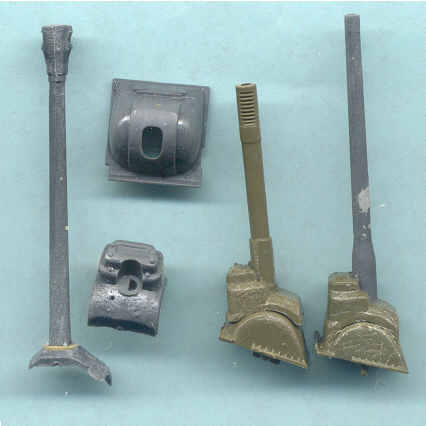
Above is a scan of the gray PST company’s mantlets and olive-green
Italeri mantlets. At far left is PST’s 122-mm D-5S barrel with
its distinctive mantlet at the base of the barrel and the mount at
the top center. Notice how the mantlet for this D-5S is different
from the mantlet for the more massive 152-mm ML20S. At far right is
Italeri’s one-piece mantlet from their wargaming kit with PST’s
122-mm A19S gun barrel. The cast gun mantlets and nose of the both
models can use some rough texturing: adequately done by applying a
coat of liquid styrene cement and then daubing with a stiff toothbrush
and small metal tools, or by a number of other acceptable methods
for this scale.
Suspension
A comparison of the wheels for these kits have been compared several
times already so I will not go much into them here. Both a okay in
molding and detail, but not Revell or Dragon quality. Italeri’s
roadwheels are more finely done but lack holes that PST does have;
these should be drilled out for a fine display model. Be careful removing
PST’s wheels from the sprues, several of mine broke along the
edge from the stress of the sprue snippers.
The IS and ISU tanks used a torsion bar suspension. Both PST and Italeri
mold their suspension arms, rather thickly, into the hull sides making
it difficult to articulate the roadwheels over rough terrain unlike
Roden’s IS-3 kit that includes separate suspension arms. Both
kits offer link & length styrene tracks with good detail; Italeri’s
tracks are a bit more sharply molded. Simon Barnes covers the tracks
and wheels well in his reviews so I will not duplicate that effort
here. When assembling I recommend that you attach the wheels and tracks
to the hull sides before attaching the sides to the upper superstructure.
This approach will help in getting all the individual links straight
and lined up.
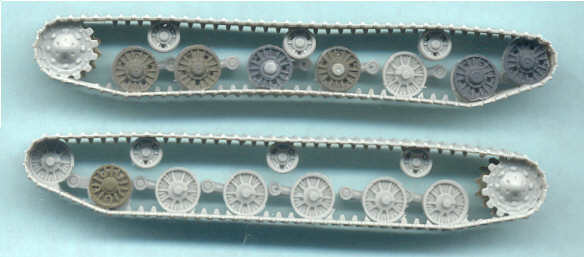
The suspension for Italeri’s wargaming, quick-build, kit comes
in just a left and a right side with all track and wheels molded together.
There is not real track-link detail and the track run is smooth. If
it were not for the wheels and tracks the quick-build kit could be
a good display model.
In the above scan is my attempt at doing some surgery & kit bashing
to replace Italeri’s wargaming tracks & wheels with the
superb light-gray styrene one-piece suspension & tracks, available
as an extra in Trumpeter’s 1/72 scale IS-3 kit. The IS-2, ISU
and the IS-3 tanks all shared the same wheels and tracks though the
IS–3 looks lower to the ground. Assembled on the Italeri kit
the Trumpeter one-piece suspension & tracks fit well and can well
pass for a tank heavily loaded. Outer roadwheels and the inner sprocket
will need to be stolen from extra’s in the PST kits or cut from
the discarded Italeri one-piece wargaming suspension. Above we see
some PST IS-2 wheels glued on, on the lower set of tracks is one of
Italeri’s roadwheels.
Instructions
Both kit makers give us exploded-view type instructions with symbols.
PST’s instructions [at right] are small and complicated compared
to Italeri’s instructions [at left], which are larger and are
broken down into more steps. Both are adequate to an intermediate
builder.
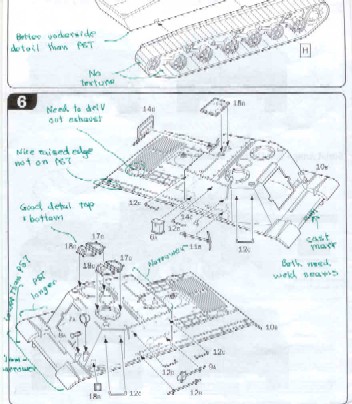
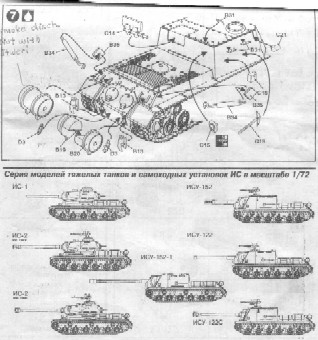
Markings
Both kits offer water applied decal markings for several vehicles,
but Italeri gives us more complete painting instructions. I have not
used these particular decals yet, but from past experience Italeri’s
have typically applied easier and clearer than my experience with
PST’s decals, though based on all the fine looking PST models
posted on the web, both look fine when properly applied.
Conclusion
Both PST and Italeri give us decent models of these Soviet assault
guns and both have certain advantages over the other. The Italeri
kit is a bit smaller than true 1/72. Fit of parts within both manufacturers’
kits was fine and have so far for me, no significant problems. With
good references both manufacturer’s models can be converted
to the modernized ISU’s of the 1950’s and 1960’s.
Now with PST releasing good KV tank models and ISU assault guns, why
have they yet to release an SU-152 model?
A Few Construction & Historical References I used for
this review:
http://www.ontheway.org.uk/reviews/Italeri/ISU152prev.htm
Simon Barnes’ review of Italeri’s ISU-152 kit at On The
Way website.
http://www.72review.org/index.php/Review:JS-2_roundup
Another great kit review at 72 Review.org website
http://www.battlefield.ru/index.php?option=com_content&task=category§ionid=5&id=29&Itemid=50
The Russian Battlefield website, one of the best on the web for information
on the development and use of Soviet World War 2 armor and artillery.
RUSSIAN TANKS OF WORLD WAR II, by Bean & Fowler, MBI Publishing
(2002). A good concise history of Soviet tank development, use and
the vehicles up to the Cold War period, in a soft cover book.
STALIN’S HEAVY TANKS 1941-1945, by Steven Zaloga, Andre Aksenov
and Aleksandr Koshchavtsev, Concord Publications (1998). A great,
not too expensive softcover reference book with text, black &
white photos and color illustrations.
http://ww2armor.jexiste.fr/Files/Allies/Allies-head.htm
A fine website on World War 2 armor and other weapons; black &
white photos, 5-view color illustrations, and history in French and
English. Owned by Vincent Bourguignon
|







